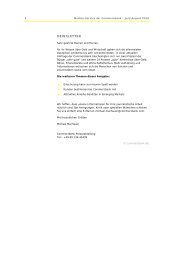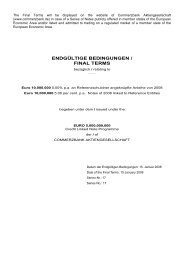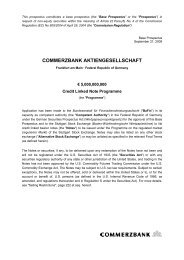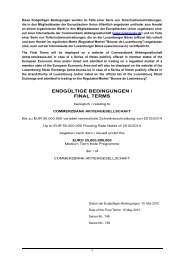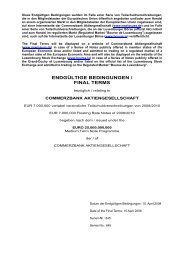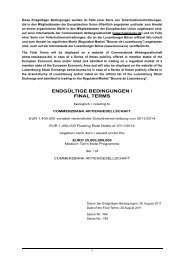COMMERZBANK AKTIENGESELLSCHAFT
COMMERZBANK AKTIENGESELLSCHAFT
COMMERZBANK AKTIENGESELLSCHAFT
You also want an ePaper? Increase the reach of your titles
YUMPU automatically turns print PDFs into web optimized ePapers that Google loves.
Group Financial Statements<br />
278<br />
222 Commerzbank Annual Report 2011<br />
(7) Cash reserve<br />
The cash reserve comprises cash on hand, balances held at<br />
central banks, debt issued by public-sector borrowers and bills<br />
of exchange eligible for rediscounting at central banks. With the<br />
exception of debt issued by public-sector borrowers, which is<br />
shown at its fair value, all the items are stated at their nominal<br />
value.<br />
(8) Claims<br />
The Commerzbank Group’s claims on banks and customers<br />
which are not held for trading and are not quoted on an active<br />
market are reported at amortised cost. Premiums and discounts<br />
are recognised in net interest income over the term of the claim.<br />
Claims on banks and customers for which the fair value option is<br />
applied are accounted for at fair value. The carrying amounts of<br />
claims to which micro fair value hedge accounting is applied are<br />
adjusted for changes in fair value attributable to the hedged risk.<br />
In portfolio fair value hedge accounting changes in fair value are<br />
reported in the balance sheet item value adjustments for<br />
portfolio fair value hedges.<br />
(9) Loan loss provisions<br />
We make provision for the particular risks of on- and off-balance<br />
sheet lending in the loans and receivables category in the form<br />
of specific loan loss provisions (SLLPs), portfolio loan loss<br />
provisions (PLLPs) and general loan loss provisions (GLLPs).<br />
When determining provisioning levels the fundamental<br />
criteria include whether the claims are in default or not and<br />
whether the claims are significant (over €1m) or insignificant<br />
(up to €1m). All claims which are in default under the Basel II<br />
regulations are identified as in default or non-performing. The<br />
following events can be indicative of a customer default:<br />
• Imminent insolvency (over 90 days past due).<br />
• The Bank is assisting in financial rescue/restructuring<br />
measures at the customer with or without restructuring<br />
contributions.<br />
• The Bank has demanded immediate repayment of its claims.<br />
• The customer is in insolvency proceedings.<br />
For significant claims which are in default we recognise specific<br />
loan loss provisions in accordance with uniform standards<br />
across the Group. The net present value of the expected future<br />
cash flows is used to calculate both specific valuation allowances<br />
as well as specific loan loss provisions. In addition to the<br />
expected payments the cash flows include the expected<br />
proceeds from realising collateral and other recoverable cash<br />
flows. The loan loss provision or valuation allowance is therefore<br />
equal to the difference between the carrying value of the loan<br />
and the net present value of all the expected cash flows. The<br />
increase in the net present value over time using the original<br />
effective interest rate (unwinding) is recognised as interest<br />
income.<br />
A portfolio loan loss provision (PLLP impaired) is recognised<br />
for insignificant defaulted claims using internal parameters.<br />
For non-defaulted claims we account for credit risk in the<br />
form of general loan loss provisions (GLLPs). The level of the<br />
general loan loss provisions, both for on- and off-balance sheet<br />
lending, is determined using parameters derived from Basel II<br />
methodology.<br />
We deduct the total loan loss provision, insofar as it relates to<br />
on-balance sheet claims, directly from the respective asset item.<br />
However, the provision for losses in off-balance sheet business<br />
(e.g. contingent liabilities, lending commitments) is shown<br />
under provisions for lending business.<br />
Unrecoverable accounts for which no specific loan loss<br />
provisions have been formed are written off immediately.<br />
Amounts recovered on claims written off are recognised in the<br />
income statement under loan loss provisions. Impaired claims<br />
are (partially) written down, utilising any specific provisions, if<br />
such claims prove to be partially or entirely unrecoverable. We<br />
also directly write off portions of impaired claims that exceed<br />
existing loan loss provisions if they are unrecoverable.<br />
(10) Repurchase agreements and securities lending<br />
Repurchase (repo) transactions combine the spot purchase or<br />
sale of securities with their forward sale or repurchase, the<br />
counterparty being identical in both cases. The securities sold<br />
under repurchase agreements (spot sale) continue to be<br />
recognised and measured in the consolidated balance sheet as<br />
part of the securities portfolio in accordance with the category to<br />
which they are assigned. The securities are not derecognised as<br />
we retain all risks and opportunities connected with the<br />
ownership of the security sold under the repurchase agreement.<br />
The same risks and opportunities therefore apply to financial<br />
assets which have been transferred but not derecognised as<br />
apply to the non-transferred financial assets described in Note 5.<br />
The inflow of liquidity from the repo transaction is shown in<br />
the balance sheet as a liability to either banks or customers,<br />
depending on the counterparty. Agreed interest payments are<br />
recognised as interest expense in net interest income according<br />
to maturity.<br />
The outflows of liquidity arising from reverse repos are<br />
accounted for as claims on customers or banks. They are<br />
measured either at fair value using the fair value option or at<br />
amortised cost. The securities bought under repurchase<br />
agreements which underlie the financial transaction (spot<br />
purchase) are not carried in the balance sheet and are thus not



